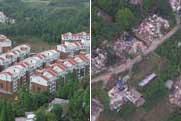China
Expert: Tibetans have unprecedented social, economic rights
Source: Xinhua | 04-03-2008 08:31
Special Report: 3.14 Tibet RiotsLHASA, April 2 (Xinhua) -- Some of the classrooms of the Lhasa No. 2 Middle School were torched during the March 14 riot, but students were seen studying the Tibetan language on Tuesday in laboratories.
Schoolmaster Degyi Zhoigar said that 85 percent of the students are Tibetan and for them, Tibetan language is a compulsory subject. More than 90 percent of the teachers are Tibetan.
Students take seven 40-minute Tibetan language classes each week, along with five classes each of Chinese, mathematics and English, she said.
"Textbooks and notebooks were burned during the violence, so we have consolidated classes and asked students to share textbooks, making sure they can go on with their studies," she said.
Statistics show that 122 textbooks in the Tibetan language, covering 16 subjects at levels from primary school to senior middle school, have been published in recent years.
Cering Gyaibo, head of the religion research institute of the Tibetan Academy of Social Sciences, told Xinhua that in terms of Tibetan language use, cultural heritage protection, religious freedom, and economic and social development, the "Tibetan people are enjoying an unprecedented range of human rights."
He said that Tibet now has more than 1,700 religious sites for Tibetan Buddhism. Most believers have scripture halls or Buddha statue niches at home. Lhasa, capital of the southwestern Tibet Autonomous Region, receives more than 1 million Buddhist visitors annually.
Tibetan Buddhists celebrate the "Saga Dawa" Festival every year, which starts from the first day of April under the Tibetan calendar and lasts for a month. During the festival, Buddhists honor the memory of Sakyamuni by walking with prayer wheels, burning joss sticks and eating vegetarian meals.
"There has been a record number of Buddhists walking with prayer wheels during the festival in recent years," he said.
The central government has allocated more than 700 million yuan(97 million U.S. dollars) since 1980 to maintain 1,400 monasteries and cultural relics.
Economic development has also improved Tibetans' living standards.
Xerab Nyi'ma, the vice president of the Central University for Nationalities and himself a Tibetan, said that as recently as the first half of the 20th century, Tibet remained a society of feudal serfdom under theocracy, one even darker and more backward than medieval Europe.
The ecclesiastical and secular serf owners, though accounting for less than 5 percent of the population of Tibet, controlled the personal freedom of the serfs and slaves who made up more than 95 percent of the population of Tibet. Owners sold, mortgaged and bartered serfs as just one more kind of property, he said.
A document in the Tibet Autonomous Region Archives, written in 1949, states that three monks, who were slaves for upper-class monks, escaped from Sera Monastery due to oppression. They were caught and thrown into prison with their eyes being gouged and noses cut off.
Another document recorded that in the past, goldsmiths, silversmiths, blacksmiths and butchers were considered lower-class people, who were not allowed to work for the government or marry upper-class people.
According to statistics, about 90 percent people in Tibet didn't have their own houses in 1950.
In 2006, the regional government launched a program to build homes for local farming and herding households. More than 570,000people have since moved into new residences and regional government spending has totaled 1.3 billion yuan.
The per capita net income of farmers and herdsmen in Tibet posted double-digit growth for a fifth consecutive year and reached 2,788 yuan in 2007, up 83.8 percent over 2002.
A total of 8.22 billion yuan was allocated for education in Tibet in past five years. More than 95 percent of school-age children now have access to primary education, in sharp contrast with the figure that 95 percent of Tibetans were illiterate before the Democratic Reform of Tibet in 1959.
According to the provincial health department, 100 percent of farmers and herders, who account for 80 percent of the region's population, are covered by the medicare system and receive free medical care.
Xerab Nyi'ma said that the implementation of the system of regional ethnic autonomy in Tibet also helped protect human rights.
For example, traditional Tibetan festivals, including the Tibetan New Year and the Shoton Festival, are legal holidays in the autonomous region.
People in Tibet work 35 hours a week, five hours less than the national legal working hours.
Xerab Nyi'ma said, during the March 14 riot, the government showed restraint, provided free medical treatment to the injured, and paid compensation to the victims. All of these showed that the Chinese government attaches great importance to human rights.
Editor:Zhang Ning



